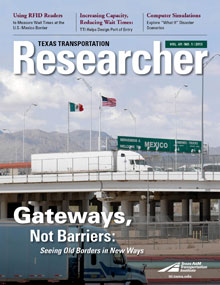For years, the movement of freight along the U.S.-Mexico border has been a long, slow process as truckers have sat idling, waiting for inspections on both sides. As a first step in making improvements, actual wait times are being measured thanks to a collaborative project including the Texas Department of Transportation (TxDOT), the Federal Highway Administration (FHWA) and the Texas A&M Transportation Institute (TTI). The project uses data gathered by radio-frequency identification (RFID) readers.

Five of the most heavily traveled border crossings (accounting for 90 percent of all truck traffic from Mexico into Texas) have been equipped with the technology. The readers gather information from RFID tags already placed on trucks crossing the border. The data reveal the time it takes a commercial vehicle to travel from Point A on the Mexican side — through Mexican, U.S. and state customs inspections — to Point B on the Texas side. U.S. Customs and Border Protection and the Texas Department of Public Safety, as well as private-sector stakeholders (e.g., shippers, carriers and international bridge operators) now have access to the data.

“To date, border wait times have been a guessing game, but now we have the technology that will provide us actual measured wait times,” says Esther Hitzfelder, TxDOT project program manager. “This tool is a significant step forward that will ultimately help us explore ways in which to improve mobility through the border.”
The hope is the data will provide a tool to help ease the congestion.
“Knowing when congestion is at its worst, shippers will be able to schedule their drivers during times when the border-crossing wait times are lower,” says TTI Associate Research Engineer Rajat Rajbhandari. Rajbhandari and TTI Mexico City Office Manager Juan Villa, TTI’s project leaders, began studying how to apply RFID technology along the border in 2007.
“We now have that data and have included them on a website, which TTI developed and maintains,” Villa says. “We are conducting meetings with the stakeholders on both sides of the border, and we’re getting feedback on the website. Once the site is finalized, we will meet with Mexican shippers and carriers and show them how to best use the data.”

Meanwhile, as part of the expanded FHWA project, RFID readers have also been installed at the Mariposa border crossing at Nogales, Arizona. Wait time data are expected to be online this year.
“The Mariposa crossing is vital for the shipment of produce from Mexico to the United States,” says Marisa Walker of the Arizona Commerce Authority. “I think this project will help all of the stakeholders realize that we are not able to build ourselves out of the border congestion issue. Instead, we are using technology to help us maximize our efforts.”


